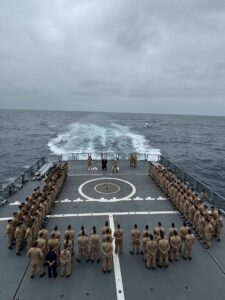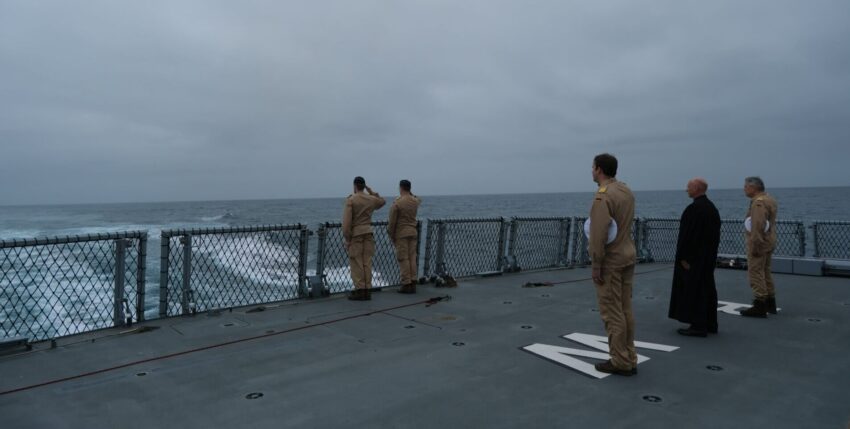The IPD24 Association of the German Navy commemorated the 1997 aircraft collision off Namibia. When a BMVg aircraft collided with a US Air Force aircraft, 33 people lost their lives, including twelve comrades from the German Navy. With a short stopover and a commemoration of the dead at sea on the Indo-Pacific Association's return journey from Cape Town to the Mediterranean, the Navy remembered the harrowing incident when two aircraft collided in the vastness of uncontrolled airspace off the African continent.

Background
The Collision occurred on 13 September 1997 over the Atlantic about 120 kilometres off the coast of the South West African State Namibia at an altitude of 35,000 feet (10,670 metres) as a head-on collision of a Tupolev Tu-154 the Flight readiness of the German Federal Ministry of Defence and a US-American Military transporter of the type Lockheed C-141 Starlifter. With the Collision all 33 occupants of both aircraft were killed.
On board the German aircraft, in addition to the crew of ten, were twelve naval personnel who were to take part in a sailing regatta in Cape Town at the invitation of the South African Navy to mark the 75th anniversary of the country's naval forces, as well as two members of the crew and a technician from Elbe Flugzeugwerke, responsible for the built-in verification sensors of the Open Skies missions.
The German Tupolev had been transferred from the GDR's National People's Army's Transport Aircraft Wing 44 (TG-44) to the Federal Republic of Germany and thus to the Bundeswehr's air force for passenger transport and for flights under the Open Skies Treaty. The two highly experienced pilots with over 7,000 and almost 4,000 flying hours had also found their way into the air force.
The aircraft involved in the accident was already equipped with the sensors for verification flights, and a sister aircraft was to be retrofitted shortly afterwards, but this was not pursued further after the incident.

The reasons for the collision were a chain of unfortunate equipment failures, failure to pass on information and the fact that neither the German nor the American aircraft had yet been equipped with a TCAS (Traffic Alert and Collision Avoidance System) collision warning device. The decisive factors, however, were the incorrect choice of the Tupolev's flight level in the flight planning, contrary to the requirements for semi-circular flight altitudes, and the lack of air traffic control in the affected area by radar surveillance and air traffic controllers.
The Tu-154 had taken off from the Cologne/Bonn air base for Cape Town, had refuelled in Niger and was supposed to make a stopover in Windhoek. Its flight plan indicated flight level 390 (39,000 feet), but it was flying at level 350 and was unable to change altitude independently due to a lack of radio contact with control centres. The US Air Force Starlifter had taken off from Windhoek on its way to Ascension Island and also stopped at flight level 350 in accordance with the regulations.
These semi-circular flight levels are prescribed according to the magnetic course flown in order to avoid collisions both in visual flight and in instrument flight. Aircraft with magnetic courses from 0° to 179° choose an odd flight level (FL230, FL250 etc.), but with courses from 180° to 359° a straight flight level (FL220, FL240 etc.), so that a vertical separation of at least 1,000 feet - above FL290 2,000 feet applies. The Tupolev should therefore have flown at FL330 or FL370 - however, the altitude flown contrary to the semi-circular flight rule was not noticed at any point.
In memory of those who died, a memorial stone was erected at Neuhardenberg airfield and a stone for the members of the naval regatta team at the Wilhelmshaven cemetery of honour. A small stele with the names of all 33 was also erected in Simon's Town on Jubilee Square - accompanied by a few lines from the poem "One Transport Lost" by the South African poet Roy Campbell (1901-1957). It tells of petrels and also of albatrosses, in which the souls of drowned sailors are said to live on.

Sources: wikipedia, ajs










